Lunch & Dinner
The Art and Science of Food Pairing
The art and science of food pairing reveals unexpected flavor combinations that can transform your culinary creations, inviting you to explore beyond the ordinary.

The art and science of food pairing helps you discover extraordinary culinary experiences by matching ingredients based on shared aromatic compounds. It goes beyond traditional pairings, offering over 10,000 potential combinations. By understanding flavor compatibility, you can create unexpected blends like chocolate with chili or roasted vegetables with Agnolotti. Tools like flavor wheels and foodpairing charts make it easier for you to explore these creative possibilities. This approach not only enhances your cooking but also elevates dining experiences, inviting you to push the boundaries of flavor. If you keep going, you'll uncover even more exciting insights into food pairing.
Key Takeaways
- Food pairing is based on shared aromatic compounds that enhance culinary experiences beyond traditional matches.
- Molecular flavor profiles dictate ingredient compatibility and reveal innovative, unexpected pairings.
- Tools like flavor wheels and mobile apps help explore successful flavor combinations scientifically.
- Successful pairings, such as chocolate with chili, create memorable culinary experiences through unique interactions.
- Experimentation with food pairing principles fosters creativity and a deeper appreciation for gastronomy.
Definition of Foodpairing

Foodpairing redefines how you think about flavor combinations in cooking. It's the practice of matching ingredients based on their shared aromatic compounds, which can enhance your culinary experiences far beyond traditional pairings.
For instance, exploring traditional Brazilian dishes like Caldeirada or Caruru can reveal unexpected ingredient combinations that align with the principles of foodpairing. Emerging in the 1990s, foodpairing gained traction through chefs like Heston Blumenthal, who embraced innovative combinations and experimented with unexpected ingredients.
Utilizing scientific principles, foodpairing identifies flavor compounds that predict successful pairings, resulting in harmonious and balanced dishes.
For instance, you might discover counterintuitive pairings like chocolate with cauliflower or balsamic vinegar with strawberries. These unique combinations reveal shared aromatic profiles that can surprise and delight your palate.
The Science of Flavor Compatibility

When you're exploring flavor compatibility, understanding molecular flavor profiles is key.
By analyzing how different compounds interact, you can discover which ingredients work well together.
For instance, the rich flavors of Red-Braised Pork Belly pair beautifully with the earthy notes of cumin found in dishes like Cumin Lamb.
This science not only enhances your cooking but also sparks creativity in your culinary adventures.
Molecular Flavor Profiles
Understanding molecular flavor profiles opens up a domain of culinary possibilities, as the specific aromatic compounds in ingredients dictate their compatibility in pairings. For instance, the sweet and fragrant notes in Kue Putu can be beautifully complemented by the rich, earthy flavors of coconut.
By focusing on these flavor compounds, you can enhance your dishes and create delightful culinary pairings. Research shows that similar chemical structures in these compounds often lead to successful pairings, making it easier to curate flavors that harmonize beautifully.
Utilizing sensory analysis techniques allows you to evaluate these combinations scientifically, providing a solid foundation for foodpairing methodologies. The flavor wheel serves as an invaluable tool, helping you visualize the relationships between various flavor compounds and identify compatible ingredients quickly.
As you explore the domain of molecular gastronomy, you'll uncover innovative pairings rooted in scientific principles, pushing the boundaries of traditional cooking.
With ongoing research, the potential for culinary creativity is limitless. By understanding molecular flavor profiles, you can confidently experiment with different combinations, creating unique dishes that surprise and delight.
Compound Interaction Analysis
At the heart of culinary creativity lies compound interaction analysis, which explores the science of flavor compatibility. This analysis focuses on identifying specific flavor compounds in ingredients based on their chemical structures. Research shows that ingredients sharing similar aromatic molecules often lead to harmonious flavor combinations, enhancing your culinary experience.
For instance, the rich blend of spices in Mushroom Masala enhances the earthy flavor of mushrooms, showcasing how complementary flavors can elevate a dish.
To evaluate the success of these pairings, sensory analysis comes into play. It assesses how well the flavor compounds complement each other on the palate. You can utilize tools like flavor wheels, which visually represent relationships between various ingredients, guiding you toward compatible pairings based on compound similarities.
Ongoing studies into flavor compatibility continue to reveal innovative pairings by analyzing the interactions of complex compounds found in diverse foods. Each discovery expands your culinary possibilities, allowing you to experiment with unexpected combinations that may surprise your taste buds.
Benefits of Innovative Pairing

Innovative food pairing can transform your dining experience by introducing unexpected flavor combinations that excite your palate. For instance, pairing sweet grilled peaches with creamy burrata cheese creates a revitalizing summer salad that highlights the beauty of seasonal ingredients.
Embracing these creative combinations not only enhances taste but also offers several benefits:
- Improved Nutritional Intake: By diversifying your food choices with innovative pairings, you can incorporate a wider range of nutrients into your meals.
- Alleviating Culinary Boredom: Experimenting with familiar ingredients through innovative pairing can reignite your passion for cooking, breaking the monotony of repetitive meals.
- Increased Vegetable Consumption: Engaging children in healthy eating becomes easier with appealing, unexpected pairings that make vegetables more enjoyable.
- Enhanced Culinary Creativity: Exploring new flavor profiles stimulates your culinary creativity, encouraging both chefs and home cooks to push the boundaries of traditional cooking.
Scientific explanations behind these innovative pairings reveal how certain flavors complement each other, providing a deeper understanding of taste dynamics.
By embracing these unexpected pairings, like nutritious nettles and potatoes, you'll not only savor more exciting meals but also cultivate healthier eating habits.
Tools for Foodpairing Exploration

When exploring the world of food pairing, having the right tools can make all the difference in your culinary journey. To enhance your foodpairing experience, consider using various software and mobile apps that analyze flavor compatibility based on shared aromatic compounds. These tools help you understand how different ingredients interact, making your food choices more informed and enjoyable.
For instance, incorporating elements like the sweet flavor of dorayaki can inspire unique pairings with other desserts or snacks.
Flavor wheels are another essential tool, illustrating relationships between different flavors. They simplify the process of discovering harmonious ingredient pairings, allowing you to create innovative combinations effortlessly. Chefs and mixologists often turn to foodpairing charts for inspiration, showcasing successful flavor matches that elevate their culinary creations.
Furthermore, online databases offer extensive taste profiles for a wide range of ingredients. You can experiment with combinations that may not be traditionally recognized, expanding your culinary horizons.
Tools like the truffle wheel also provide insights into compatible ingredients for specific foods, enhancing your understanding of how to pair ingredients effectively based on their chemical similarities.
Successful Flavor Combinations

Exploring food pairing tools opens up a world of successful flavor combinations that can elevate any dish. By understanding the science behind flavors, you can create memorable culinary experiences.
For example, the rich and savory nature of Agnolotti can be beautifully complemented by the sweetness of roasted vegetables. Here are a few key pairings to inspire your creativity:
- Chocolate and Chili – Their shared aromatic compounds create a rich, harmonious blend.
- Citrus with Seafood – The bright acidity of citrus enhances the freshness of seafood, balancing its richness.
- Cheese and Fruit – Combining creamy textures with sweet flavors results in a well-rounded palate experience.
- Kiwi with Oysters – An unexpected combination that showcases the versatility of the Foodpairing methodology.
Utilizing flavor wheels and pairing charts can help you visually explore these innovative combinations. They encourage you to experiment beyond traditional culinary practices and discover unexpected combinations that work beautifully together.
With over 10,000 potential pairings identified, you'll find that successful flavor combinations often hinge on shared aromatic compounds. Embrace the art and science of food pairing, and don't hesitate to push the boundaries of your culinary creations!
Insights From Culinary Experts

Culinary experts often dive deep into the world of flavor pairing, sharing their valuable insights to inspire both home cooks and professionals alike. They emphasize the importance of understanding aromatic molecules and how these influence your food choices with outcomes. By leveraging scientific principles, chefs create contemporary combinations and classic dishes that yield delicious culinary results.
When experimenting in the kitchen, you might discover unheard-of pairings that surprise your palate. Here's a glimpse of some intriguing flavor matches recommended by culinary experts:
| Flavor Profile | Suggested Pairings |
|---|---|
| Citrus | Avocado, Fish, Dark Chocolate |
| Herbs | Peas, Lamb, Goat Cheese |
| Spices | Chocolate, Coffee, Nuts |
| Fruits | Cheese, Cured Meats, Nuts |
| Vegetables | Berries, Dairy, Grains |
Utilizing the Foodpairing methodology, culinary professionals enhance menu design, creating dynamic dining experiences that excite patrons. By stepping outside traditional boundaries, you can explore new flavors and discover unique combinations that elevate your cooking to new heights. This approach allows chefs to draw inspiration from a variety of global cuisines, incorporating techniques and ingredients from around the world. Whether it’s infusing a classic French dish with Asian flavors or creating a fusion of Mediterranean and Latin American cuisine, the possibilities are endless when utilizing the Foodpairing methodology. By embracing diverse culinary traditions, chefs can create truly remarkable and innovative dishes that captivate diners.
Frequently Asked Questions
What Is the Art and Science of Foodpairing Analysis?
Foodpairing analysis combines creativity and scientific principles. You explore aromatic molecules and their compatibility, using tools like flavor wheels to discover unexpected combinations, transforming your culinary adventures and expanding your palate with innovative pairings.
Conclusion
In exploring the art and science of food pairing, you reveal a world of flavor possibilities. Did you know that 90% of our taste experience comes from our sense of smell? Imagine the aroma of fresh basil mingling with ripe strawberries, creating an unexpected yet delightful sensation. By experimenting with innovative combinations, you'll not only enhance your culinary skills but also surprise your guests, turning every meal into a memorable experience. Immerse yourself and let your creativity flourish!
Caterina, with her background as a food scientist and innovative chef, is the driving force behind our product development. Her keen eye for detail and relentless pursuit of perfection guide her as she curates our collection of extraordinary ingredients, beverages, and culinary experiences. Whether she’s sourcing the rarest spices or collaborating with master artisans, Caterina’s passion for elevating the culinary landscape shines through in every new discovery that graces our shelves.
Lunch & Dinner
The Fascinating World of Molecular Gastronomy
Fascinating flavors and textures await in the world of molecular gastronomy, where culinary innovation transforms traditional dishes into unforgettable experiences. Discover the secrets behind it.

Molecular gastronomy combines culinary artistry with scientific principles, allowing you to experience food in innovative ways. Techniques like spherification and foaming enhance textures and flavors, transforming traditional dishes into extraordinary experiences. With pioneering chefs like Ferran Adrià leading the charge, this movement pushes culinary boundaries and challenges how you perceive flavor and presentation. Vital tools such as sous-vide machines and siphon whips are essential for success in this field. As you explore this fascinating world, you'll discover more about its rich history and the techniques that can elevate your cooking to a whole new level.
Key Takeaways
- Molecular gastronomy merges culinary arts with food science, focusing on physical and chemical transformations during food preparation.
- Key techniques include spherification, foaming, and sous-vide, enhancing textures and presentations in innovative ways.
- Influential figures like Ferran Adrià and Elizabeth Cawdry Thomas have significantly shaped the movement since its formal introduction in 1992.
- Essential tools for molecular gastronomy include sous-vide machines, siphon whips, and precision scales to ensure accurate measurements and results.
- The discipline transforms high-end dining, encouraging unique culinary creations while emphasizing the importance of grounding techniques in solid science.
What Is Molecular Gastronomy?

Molecular gastronomy is a fascinating culinary discipline that combines food science with innovative cooking techniques. You'll discover that this movement focuses on the physical and chemical transformations that occur during food preparation, revealing the science behind what you eat.
Introduced in 1992 during the Erice Workshops in Sicily, the term emphasizes the importance of understanding cooking processes on a molecular level. This discipline can parallel the intricate flavors of Brazilian cuisine, where diverse cultural influences and unique ingredients come together to create remarkable dishes.
Key techniques like spherification, foaming, and sous-vide allow chefs to create unique textures and presentations, pushing the boundaries of traditional cooking. When you explore molecular gastronomy, you'll find that it challenges long-held beliefs about how food should be prepared and enjoyed.
Influential figures such as Ferran Adrià and Hervé This have considerably shaped this culinary movement, with Adrià famously pioneering the use of foams and spherification.
This discipline encourages you to experiment and dive deeper into the science of flavor and texture. By mastering these molecular techniques, you can elevate your cooking, creating dishes that not only taste incredible but also surprise and delight your guests.
Embrace the wonder of molecular gastronomy, and transform your culinary creations into unforgettable experiences.
Historical Background and Evolution

Molecular gastronomy has its roots in the innovative practices of medieval and Renaissance chefs, who began merging science with cooking.
Traditional techniques, such as slow braising, can be seen as early forms of manipulating ingredients to create profound flavors, similar to dishes like Red-Braised Pork Belly.
You'll find that key figures, like Elizabeth Cawdry Thomas, played a significant role in bringing this culinary approach to the forefront in the 1990s.
As you explore its evolution, you'll notice how early scientific methods laid the groundwork for what we now recognize as molecular gastronomy.
Origins of Molecular Gastronomy
While many culinary traditions have embraced scientific principles for centuries, the formalization of molecular gastronomy as a distinct movement began in 1992 at the Erice Workshops in Sicily, organized by Elizabeth Cawdry Thomas. This event marked a pivotal moment where chefs and scientists gathered to explore the origins of molecular gastronomy, blending culinary arts with food science.
The intersection of culinary experiences and scientific exploration is evident in various global cuisines, as seen in the rich flavors of Asian cuisine, where traditional cooking techniques often incorporate innovative approaches.
The historical roots of this movement can be traced back to medieval and Renaissance chefs who experimented with early scientific cooking techniques. Significantly, the 15th-century manuscript "The Vivendier" documents some of these daring methods, albeit with significant risks.
The invention of the pressure cooker by Denis Papin in the 17th century further laid the groundwork for understanding how pressure and heat transform food, concepts that are central to molecular gastronomy today.
As the late 20th century unfolded, advancements in food science fueled the movement, leading to a fusion of chemistry with cooking. This evolution sparked discussions about the nature of molecular gastronomy, including debates on its necessity and perceived elitism in the culinary world.
Key Influential Figures
The evolution of molecular gastronomy owes much to the influential figures who have shaped its landscape. In 1992, Elizabeth Cawdry Thomas introduced the term at the Erice Workshops in Sicily, marking a pivotal moment for the discipline. Among the key influential figures, Ferran Adrià stands out for his groundbreaking techniques at El Bulli, including foam and reverse spherification. Grant Achatz also plays a significant role, pushing boundaries with his innovative cuisine.
Dr. Harold McGee's writings provide essential scientific insights, bridging food science and culinary arts. He's influenced countless chefs and food enthusiasts, enhancing their understanding of cooking principles. Additionally, physicist Nicholas Kurti coined the term "molecular gastronomy" and collaborated with chefs to emphasize the scientific aspects of cooking. The historical contributions of chefs like Marie-Antoine Carême laid the groundwork for the artistic presentations now seen in this culinary movement.
| Influential Figure | Contribution |
|---|---|
| Elizabeth Cawdry Thomas | Introduced the term in 1992 |
| Ferran Adrià | Pioneered techniques at El Bulli |
| Grant Achatz | Innovated modern molecular cuisine |
| Dr. Harold McGee | Provided scientific insights |
| Nicholas Kurti | Coined the term and emphasized science |
Key Techniques and Innovations

In the exciting domain of culinary exploration, key techniques and innovations in molecular gastronomy revolutionize how we experience food.
One enchanting method is spherification, which transforms liquids into gel-like spheres that burst with flavor when you bite into them. For instance, imagine a tiny sphere of savory Mushroom Masala sauce exploding on your palate!
Foaming is another key technique that adds airy textures to your dishes. Using a siphon whip and emulsifiers, chefs create light, fluffy foams that enhance both mouthfeel and visual appeal. When you try a dish with foamed elements, you'll notice how it elevates the entire experience.
Sous-vide cooking, where food is vacuum-sealed and cooked at precise temperatures, guarantees that your ingredients come out perfectly tender and evenly cooked every time.
Gelification, employing gelling agents like agar-agar or gelatin, allows chefs to craft innovative textures that delight and surprise.
Lastly, creative presentation is essential in molecular gastronomy. Techniques that challenge traditional plating not only enhance the look of your meal but also elevate your overall dining experience.
Embrace these key techniques and watch how they transform your culinary adventures!
Essential Tools for Cooking
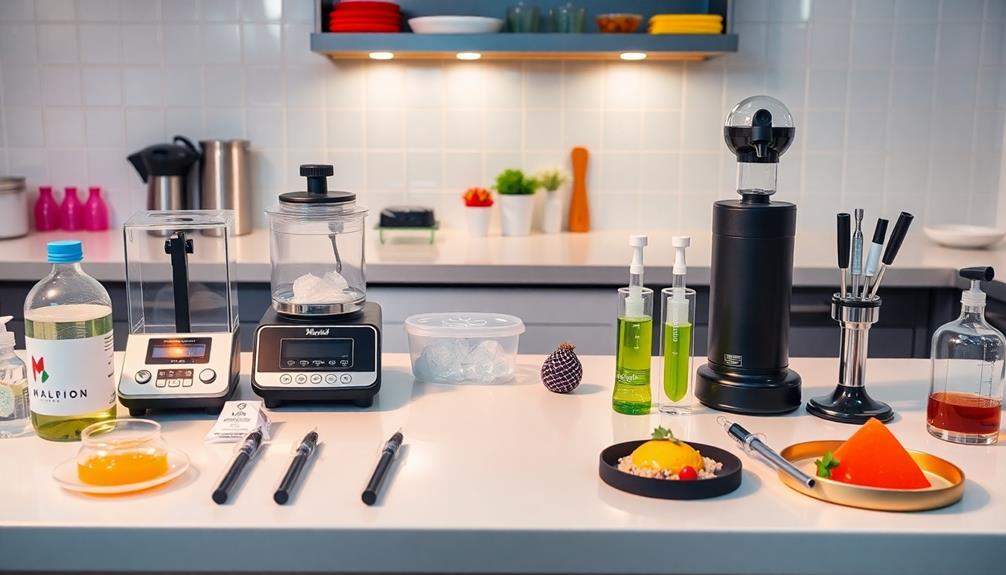
Essential tools are essential for mastering molecular gastronomy and releasing your culinary potential. In the world of molecular gastronomy, having the right equipment can make all the difference in achieving innovative and delicious results. Here's a breakdown of some essential tools for cooking that you should consider adding to your kitchen:
| Tool | Purpose |
|---|---|
| Sous-Vide Machine | Maintains precise temperature control for even cooking |
| Siphon Whip | Creates foams and espumas for innovative textures |
| Immersion Blender | Blends ingredients smoothly and makes emulsions |
| Molecular Gastronomy Kit | Contains specialized ingredients and tools for experimentation |
| Precision Scale | Measures ingredients accurately, important for strict recipes |
Influential Figures and Contributors

When you explore the world of molecular gastronomy, you'll encounter key figures who shaped its evolution.
Innovators like Ferran Adrià and Hervé This introduced groundbreaking techniques that transformed culinary practices, similar to how classic American comfort foods like the Loaded Baked Potato have evolved over time.
You'll also notice how gender dynamics play a role in the recognition of contributors within this fascinating field.
Pioneers of Molecular Gastronomy
Molecular gastronomy has been shaped by several influential figures who've pushed the boundaries of culinary art and science. One of the most notable is Ferran Adrià, whose work at El Bulli revolutionized modern cuisine with techniques like foaming and reverse spherification. His adventurous approach inspires many chefs today, including those who explore traditional dishes like Agnolotti, showcasing regional culinary skills.
Dr. Harold McGee, a respected food scientist, has greatly influenced the understanding of molecular gastronomy principles through his writings on the chemistry of cooking.
Then there's Nicholas Kurti, a physicist who coined the term "molecular gastronomy" and was among the first to advocate for a scientific study of cooking, laying essential groundwork for this culinary movement.
Hervé This, a leading chemist and co-founder of molecular gastronomy, has conducted extensive research on the scientific processes behind cooking and flavor, further enriching the field.
Finally, Grant Achatz, chef of the acclaimed restaurant Alinea, is celebrated for his innovative presentations that incorporate molecular gastronomy techniques into high-end dining experiences, making each meal a sensory adventure.
These pioneers have collectively transformed the culinary landscape, making molecular gastronomy a fascinating blend of science and art.
Key Techniques and Innovations
Key techniques and innovations in molecular gastronomy showcase the dynamic interplay between culinary creativity and scientific principles. Renowned chef Ferran Adrià revolutionized the field with pioneering methods like foam and reverse spherification, which have become staples in modern cooking. His work demonstrates how molecular gastronomy can transform textures and flavors, elevating dining experiences.
By incorporating fresh, seasonal ingredients, such as those found in farm-to-table cooking, chefs can enhance the quality and taste of innovative dishes.
Dr. Harold McGee's scientific insights into the chemistry of cooking provide foundational knowledge that supports various molecular gastronomy techniques. His research helps you understand how ingredients interact, allowing you to create dishes that surprise and delight.
Nicholas Kurti, an early advocate of molecular gastronomy, highlighted the importance of scientific inquiry in culinary practices, asserting that a deeper understanding of science could enhance cooking. Grant Achatz's Alinea takes this to heart, with its artistic presentations and innovative techniques pushing the boundaries of traditional dining.
The Erice Workshops, organized by Elizabeth Cawdry Thomas, further foster collaboration between chefs and scientists, promoting experimentation. These gatherings have been instrumental in solidifying molecular gastronomy as a legitimate and exciting culinary discipline, inspiring you to explore the endless possibilities in the kitchen.
Gender Dynamics in Recognition
Although the contributions of women in molecular gastronomy are considerable, their recognition often lags behind that of their male counterparts. You mightn't realize that women like Elizabeth Cawdry Thomas have made critical advancements in culinary science yet remain underappreciated in culinary history.
The narrative often highlights male figures, overshadowing the important roles women have played in this innovative field. For instance, the intricate techniques used in traditional Japanese cuisine, such as preparing Dorayaki (Red Bean Pancake), showcase the artistry and precision that women have historically brought to the culinary world.
Consider the early 19th-century chef Marie-Antoine Carême, who emphasized aesthetics and complexity in cooking. While he's revered, women's contributions during this period and beyond have been marginalized.
Despite being involved in key workshops and pioneering culinary innovations, gender dynamics have limited visibility for female chefs in molecular gastronomy.
Prominent male chefs like Ferran Adrià and Grant Achatz have certainly popularized this culinary movement, but it's important to recognize the women who've also contributed considerably.
As you explore this fascinating world, remember that the recognition of female chefs is evolving. A more inclusive culinary history is needed, one that acknowledges diverse influences and celebrates the contributions of all figures, regardless of gender, in shaping molecular gastronomy.
Impact on Culinary Practices
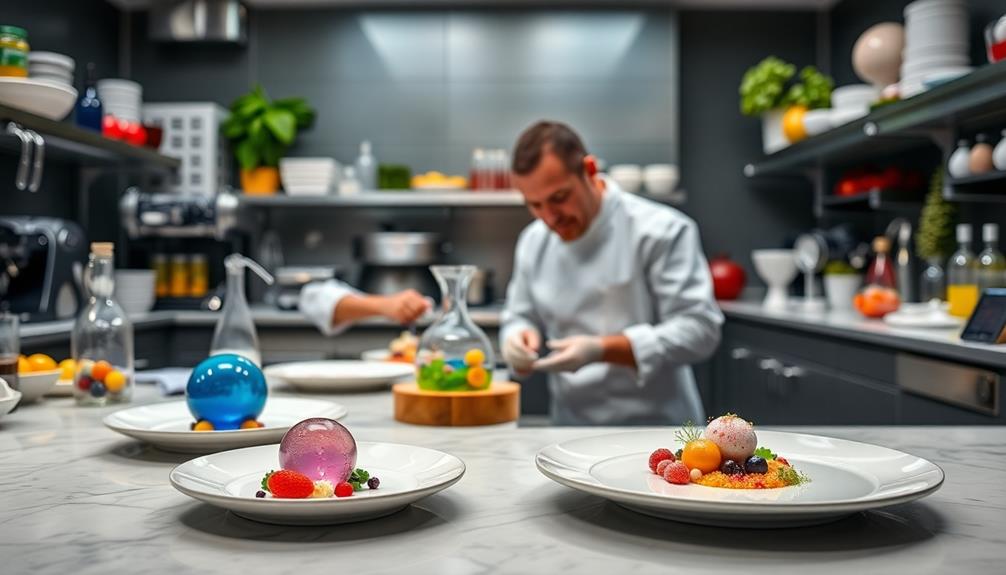
The rise of molecular gastronomy has transformed culinary practices, particularly in high-end dining establishments. Restaurants like El Bulli have pioneered innovative techniques, earning global acclaim and multiple titles as the Best Restaurant in the World.
This movement encourages you, as a chef, to explore the scientific principles of cooking, leading to unique textures and presentations that challenge traditional culinary norms. In the same way that traditional Indonesian desserts like Kue Putu showcase a unique preparation method, molecular gastronomy invites chefs to experiment with new forms and flavors.
Techniques such as spherification and sous-vide have become mainstream, enabling you to manipulate the physical and chemical properties of ingredients. This not only enhances flavor but also elevates the aesthetic appeal of dishes.
As molecular gastronomy gains traction, there's a greater interest in culinary science, resulting in educational workshops and resources that bridge the gap between chefs and food scientists.
However, critics caution against the potential misuse of these techniques, which can lead to negative perceptions. They emphasize the need to ground creative applications in solid scientific principles to maintain credibility.
Ultimately, molecular gastronomy has reshaped how you approach cooking, pushing the boundaries of what's possible in the kitchen while inviting ongoing exploration and innovation.
Exploring Flavor and Texture
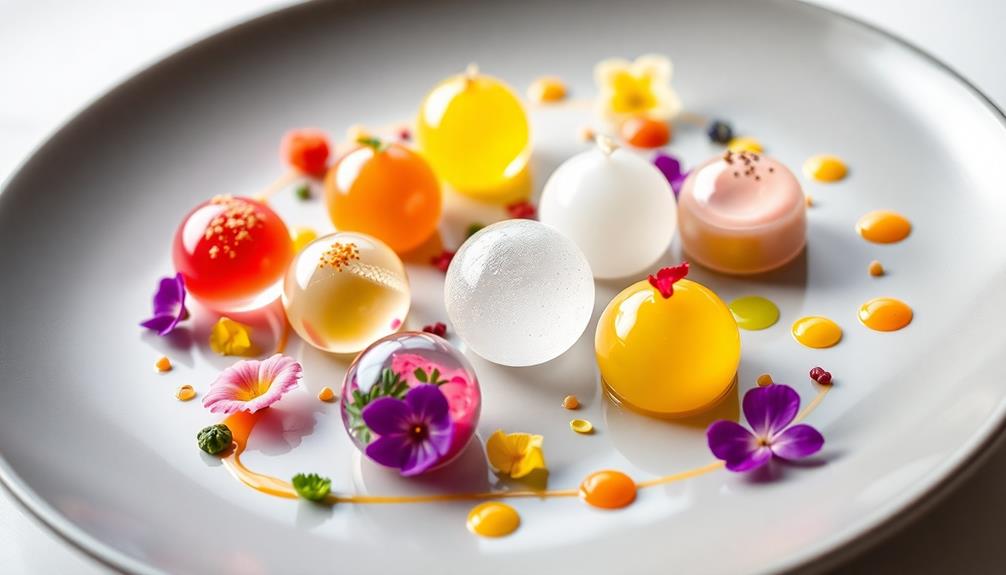
As you explore the world of molecular gastronomy, you'll discover how manipulating flavor and texture can elevate your culinary creations. This innovative approach focuses on the physical and chemical properties of food, allowing you to craft unique dining experiences.
Techniques like spherification transform liquids into gel-like spheres that burst with flavor, enhancing each bite and enchanting your guests' senses. Just as traditional Ethiopian dishes like Yekolo (Roasted Barley) showcase a unique texture and flavor, molecular gastronomy can similarly surprise and delight your palate.
Foams and espumas, created with a siphon whip and emulsifiers, introduce an airy texture that intensifies flavors from concentrated ingredients. Imagine drizzling a delicate foam over a dish, adding both visual appeal and a surprising taste sensation.
Additionally, sous-vide cooking lets you vacuum-seal food and cook it at precise temperatures, resulting in tender, flavorful dishes that maintain their integrity.
Understanding the science behind flavor perception is essential in molecular gastronomy, as factors like temperature and salt concentration can dramatically alter taste experiences. By experimenting with these elements, you can influence culinary presentations and pairings, creating a memorable meal.
Embrace the possibilities of molecular gastronomy, and watch how your dishes come alive with exciting flavors and fascinating textures.
Practical Tips for Success
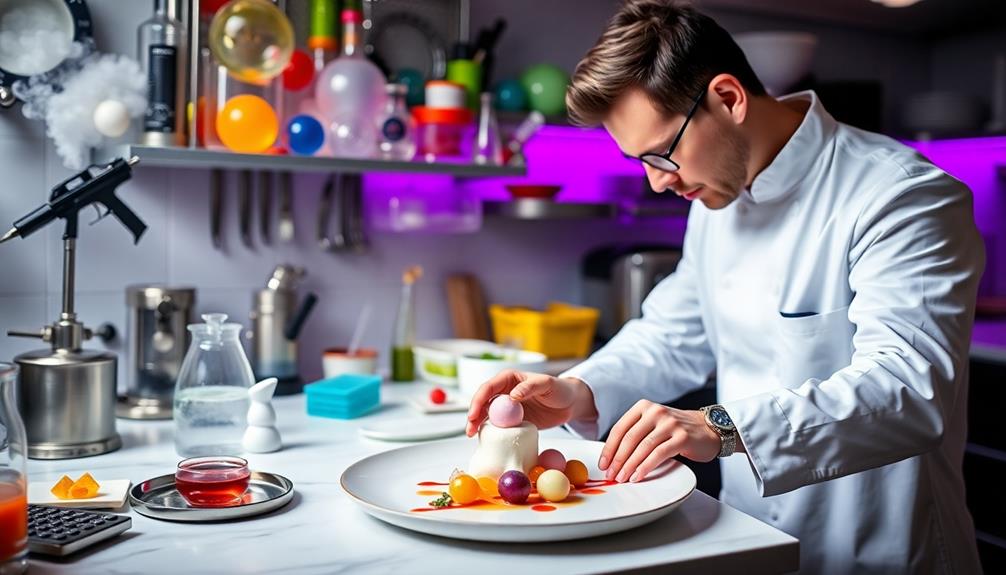
To succeed in molecular gastronomy, start with simple techniques like spherification and foaming, allowing you to build confidence and understanding before tackling more intricate methods. Follow recipes meticulously, paying close attention to precise measurements, often down to the nanogram, to guarantee successful outcomes.
Invest in essential tools like a precision scale, sous-vide machine, and siphon whip, as they're critical for achieving the desired textures and presentations in molecular gastronomy. Experiment with plating and presentation techniques to enhance the visual appeal of your dishes, since aesthetics play a significant role in the dining experience.
Practice patience and embrace the learning process; mastering molecular gastronomy requires time, experimentation, and a willingness to learn from both successes and failures.
| Key Element | Importance |
|---|---|
| Simple Techniques | Build confidence and foundational skills |
| Precise Measurements | Guarantee successful outcomes |
| Essential Tools | Achieve desired textures and presentations |
| Plating Techniques | Enhance visual appeal of dishes |
| Patience & Experimentation | Key to mastering molecular gastronomy |
Future Trends in Gastronomy

Exciting changes are on the horizon for gastronomy, with molecular techniques steadily making their way into everyday cooking.
You'll notice chefs increasingly integrating scientific methods to enhance flavor and presentation, bringing molecular gastronomy to the forefront of mainstream culinary practices.
One major trend is the rise of plant-based molecular gastronomy.
As you explore menus, expect to see innovative dishes that experiment with new textures and flavors from vegetables and alternative proteins, catering to your growing interest in sustainable dining options.
Technology is also revolutionizing meal preparation.
With advancements like 3D food printing and smart kitchen devices, you'll experience greater creativity and precision in your meals.
Moreover, the focus on sensory dining experiences is likely to grow.
Chefs are delving into the emotional and psychological effects of food presentation and flavors, enhancing your overall dining experience beyond just taste.
Frequently Asked Questions
Why Is Molecular Gastronomy Risky?
Molecular gastronomy's risky because it requires precise measurements and techniques. If you don't understand ingredient properties or follow safety protocols, you might end up with unsafe food or even face physical hazards during preparation.
What Is the Concept of Molecular Gastronomy?
Imagine a culinary laboratory where flavors dance and textures transform. Molecular gastronomy blends science and cooking, letting you explore innovative techniques like spherification and sous-vide, unveiling new dimensions in taste and presentation you never thought possible.
Who Is the Father of Molecular Gastronomy?
If you're curious about the father of molecular gastronomy, it's Hervé This. He's revolutionized culinary science, making complex concepts accessible to chefs, and his collaborations have sparked innovative techniques in cooking you might enjoy exploring.
What Chef Is Known for Molecular Gastronomy?
If you're exploring molecular gastronomy, you'll likely hear about Ferran Adrià. He's renowned for his innovative techniques, transforming traditional cooking into an extraordinary experience. His work at El Bulli changed how chefs approach food.
Conclusion
In the vibrant domain of molecular gastronomy, you're not just cooking; you're crafting an experience that tantalizes the senses. As you explore new techniques and flavors, remember that innovation is at your fingertips. Immerse yourself in this culinary adventure, where each dish is a canvas waiting for your unique touch. With a sprinkle of creativity and a dash of science, you can transform the ordinary into the extraordinary. So, what masterpiece will you create next?
Caterina, with her background as a food scientist and innovative chef, is the driving force behind our product development. Her keen eye for detail and relentless pursuit of perfection guide her as she curates our collection of extraordinary ingredients, beverages, and culinary experiences. Whether she’s sourcing the rarest spices or collaborating with master artisans, Caterina’s passion for elevating the culinary landscape shines through in every new discovery that graces our shelves.
Lunch & Dinner
How Cooking Methods Affect Nutrient Content
Preserving nutrients while cooking is essential for a healthy diet; discover which methods maximize your meals’ vitamin content and why it matters.
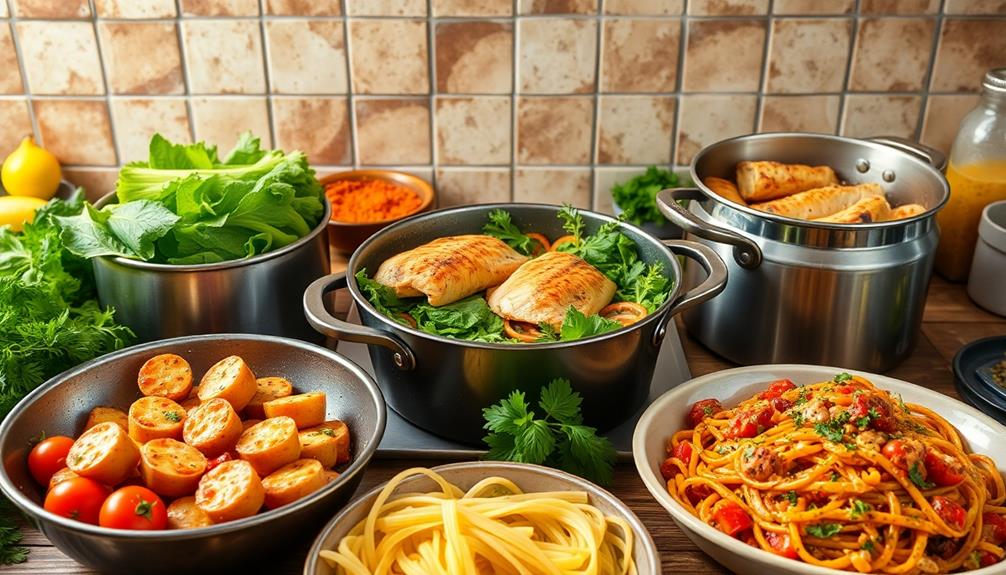
Cooking methods greatly impact the nutrient content of your meals. Steaming and microwaving are excellent choices, as they can preserve over 90% of vitamin C. In contrast, boiling can cause significant losses, up to 70% of water-soluble vitamins. While techniques like stir-frying enhance nutrient absorption, deep-frying can increase calories and reduce nutrients. To maximize health benefits, consider using minimal water, shorter cooking times, and the cooking liquid itself to reclaim valuable nutrients. The way you cook can drastically change the nutritional value, and there's much more to explore about optimizing your cooking techniques.
Key Takeaways
- Steaming and microwaving preserve up to 90% of vitamin C, retaining more nutrients than boiling or frying.
- Boiling vegetables can cause 50-70% loss of water-soluble vitamins, particularly vitamin C.
- Stir-frying enhances absorption of fat-soluble vitamins, increasing nutrient availability significantly.
- Consuming cooking liquids can recover 100% of minerals and 70-90% of B vitamins lost during cooking.
- Cooking methods like grilling and baking are healthier for meat, preserving omega-3 fatty acids better than frying.
Nutrient Retention in Cooking Methods

When it comes to nutrient retention in cooking methods, the differences can be striking. For example, steaming is a champion when it comes to preserving vitamin C, maintaining up to 90% of this essential nutrient. In dishes like Nettle and Potato Soup, where fresh ingredients are celebrated, steaming can help retain their nutritional benefits.
On the flip side, boiling can lead to significant nutrient loss, with water-soluble vitamins like vitamin C suffering losses of 50-70%. If you're looking for efficiency, microwaving is also a great choice, as it retains over 90% of vitamin C due to shorter cooking times and minimal water usage.
Stir-frying, on the other hand, improves the bioavailability of fat-soluble vitamins. When you stir-fry carrots, you can enhance beta carotene absorption by 6.5 times compared to eating them raw.
Other methods like grilling and baking generally do well in preserving the nutritional quality of meats and vegetables, but deep-frying can increase calorie content while causing some nutrient loss.
Impact of Water-Based Cooking

Water-based cooking methods, such as boiling, simmering, and poaching, can greatly affect the nutrient content of your food. For instance, boiling vegetables can lead to considerable nutrient loss, with up to 50% of vitamin C leaching into the water. Dishes like Chinese Steamed Egg showcase how steaming can preserve natural flavors and nutrients effectively.
Simmering meat might result in a loss of up to 60% of B vitamins. However, if you consume the cooking liquid, you can retain 100% of minerals and 70-90% of B vitamins.
Steaming stands out as a more effective water-based cooking method for preserving nutrients—maintaining up to 90% of vitamin C due to reduced water contact and gentler cooking processes. Notably, boiling fish is noted to better preserve omega-3 fatty acids compared to other cooking methods, highlighting how your choice of cooking methods can greatly impact nutrient retention.
Microwaving vegetables also proves advantageous, retaining over 90% of vitamin C because it typically involves shorter cooking times and less water than traditional boiling methods.
Techniques for Nutrient Preservation
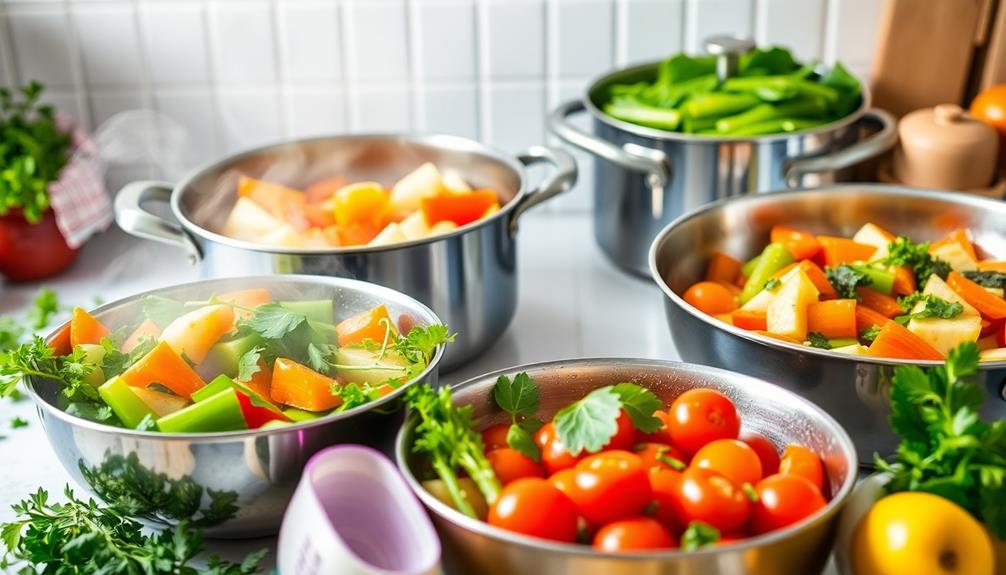
To maximize nutrient preservation in your meals, employing effective cooking techniques is essential. Opt for cooking methods like steaming and microwaving, which can preserve up to 90% of vitamin C content in vegetables.
For instance, when cooking dishes like Mushroom Masala, employing steaming can enhance the retention of vitamins while keeping the rich flavors intact. In contrast, boiling can lead to significant nutrient loss, with 50-70% of vitamin C disappearing.
To protect water-soluble vitamins, use minimal water during cooking and try to keep cooking times shorter; sautéing vegetables can maintain more vitamins than prolonged boiling or roasting.
Stir-frying is another great technique, as it enhances the absorption of fat-soluble vitamins. For example, studies show you can absorb 6.5 times more beta carotene from stir-fried carrots than from raw.
Lower temperatures also play a vital role in nutrient preservation. If you do boil vegetables, consider using the cooking liquids, like broth, to reclaim valuable minerals and 70-90% of B vitamins.
Cooking Meat and Fish Effectively

Cooking meat and fish effectively requires attention to both methods and temperatures to guarantee safety and nutrient retention. Choosing the right cooking methods can greatly impact the nutrient content of your meals.
Steaming and poaching are great options for cooking fish, as they preserve omega-3 fatty acids and moisture better than frying, which can lead to vitamin losses and texture issues. For example, dishes like Hiyashi Chuka (Cold Ramen) showcase how the right preparation can enhance flavor while maintaining nutritional value.
When it comes to meat, grilling, baking, or steaming are healthier choices compared to frying, which can add harmful fats and compounds. It's essential to adhere to proper cooking temperatures to eliminate harmful bacteria. For instance, ground meats must reach an internal temperature of 160°F for safety.
To further enhance health benefits, avoid charring or overcooking your meat, as these practices can create harmful compounds. Using marinades can also help retain nutrients while adding flavor.
Raw vs. Cooked Nutritional Benefits
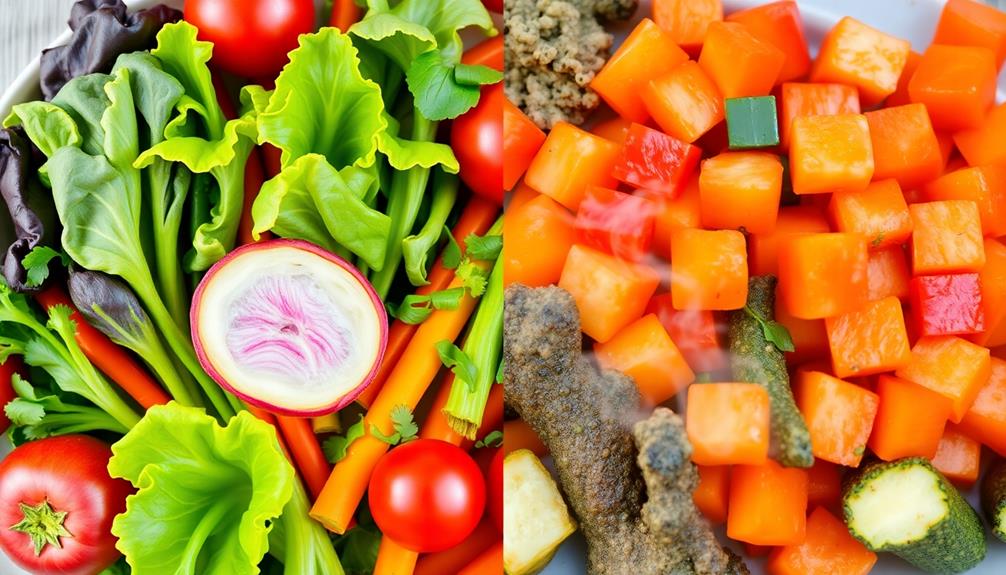
When contemplating the nutritional benefits of raw versus cooked foods, you'll find that both preparation methods offer unique advantages. For example, certain traditional Brazilian dishes like Caldeirada showcase the nutritional power of seafood, which is enhanced through cooking methods that maximize nutrient absorption.
Raw vegetables maintain certain enzymes and vitamins that cooking can destroy, providing a fresh source of nutrients. However, cooking methods can greatly enhance the bioavailability of other nutrients. For instance, the absorption of beta-carotene from cooked carrots increases by 6.5 times compared to when they're raw.
While boiling spinach can lead to a loss of vitamin C—up to 57.85%—microwaving retains over 90% of this crucial nutrient. Cooking tomatoes boosts lycopene levels by 80% when sautéed in olive oil, making them more accessible.
Additionally, ingredients like cassava, commonly used in Brazilian cuisine, can offer different health benefits depending on whether they're consumed raw or cooked, highlighting the importance of cooking methods in preserving and enhancing nutrients regional culinary traditions.
It's essential to evaluate the nutrient content and how heat affects it. Cooking can reduce antinutrients, enhancing absorption of beneficial compounds, while raw foods can be rich in certain vitamins.
Balancing raw and cooked vegetables in your diet optimizes nutritional value, allowing you to maximize the benefits of both preparation methods. By understanding these differences, you can make informed choices that contribute to your overall health and well-being.
Frequently Asked Questions
How Do Cooking Methods Affect Nutritional Value?
Cooking methods really impact nutritional value. When you boil, you might lose vitamins, while steaming or microwaving preserves most nutrients. Quick methods like stir-frying enhance nutrients, making your meals both tasty and healthy.
Which Cooking Method Destroys Nutrients?
Certain cooking methods, like boiling and prolonged roasting, destroy nutrients. You'll lose significant amounts of water-soluble vitamins, especially when you overcook. To preserve nutrients, consider quicker methods like microwaving or stir-frying for shorter durations.
Which Cooking Methods Could Lose Nutrients?
Oh, the joys of boiling! You're practically flushing nutrients down the drain. Frying? It's a one-way ticket to Fatville. Simmering? Say goodbye to B vitamins. Stick to microwaving for a nutrient-saving miracle, if you're lucky!
How Does Cooking Affect the Vitamin Content of Food?
Cooking affects vitamin content by altering nutrient retention. You'll find that methods like steaming and microwaving preserve more vitamins, while boiling can lead to significant losses. Choosing your cooking techniques wisely can maximize nutrient intake.
Conclusion
To sum up, understanding how cooking methods affect nutrient content is essential for maximizing your meals' health benefits. Just like a sponge soaks up water, different techniques can either retain or drain nutrients from your food. By opting for gentle cooking methods and being mindful of water usage, you can keep more vitamins and minerals intact. Remember, a little knowledge goes a long way in ensuring your meals are as nutritious as they are delicious!
Caterina, with her background as a food scientist and innovative chef, is the driving force behind our product development. Her keen eye for detail and relentless pursuit of perfection guide her as she curates our collection of extraordinary ingredients, beverages, and culinary experiences. Whether she’s sourcing the rarest spices or collaborating with master artisans, Caterina’s passion for elevating the culinary landscape shines through in every new discovery that graces our shelves.
Lunch & Dinner
The Psychology Behind All-You-Can-Eat Buffets
Discover how psychological triggers at all-you-can-eat buffets influence your choices and behavior, leaving you questioning your dining decisions. What really drives your cravings?
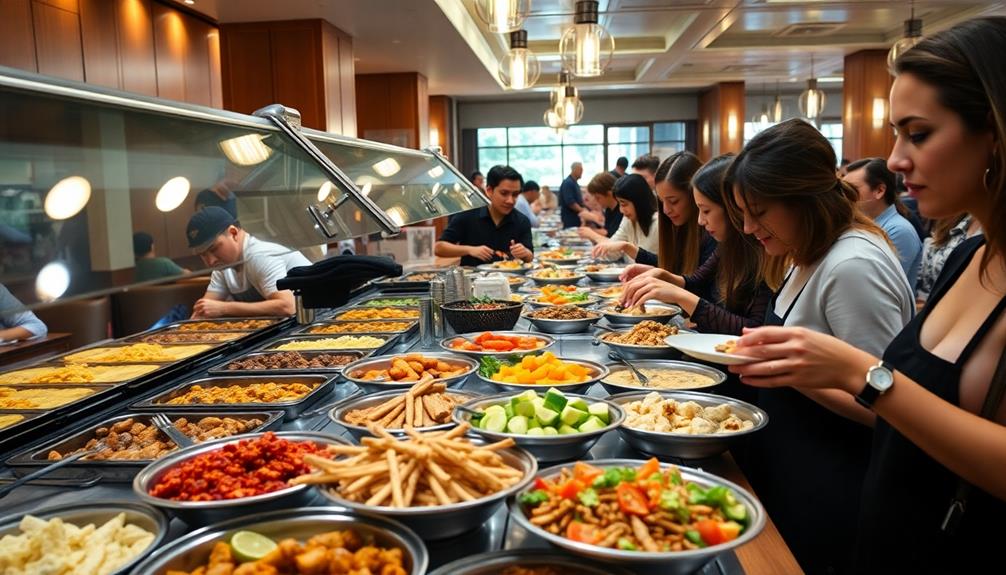
All-you-can-eat buffets play on your psychology in fascinating ways. You might feel driven to overindulge due to the abundance mindset, pushing you to maximize your meal's value. Decision fatigue can arise from the overwhelming choices, leading to impulsive selections rather than thoughtful ones. Social dynamics also influence your plate size, as you often mirror your dining companions. While the joy of variety excites your taste buds, guilt can creep in after overindulgence. Understanding these psychological triggers can enhance your buffet experience, making it more enjoyable. There's a lot more to discover about how buffets shape your dining behavior.
Key Takeaways
- Abundance mindset drives overconsumption, with diners feeling compelled to maximize their value from the buffet experience, often leading to excessive portion sizes.
- Decision fatigue stems from overwhelming choices, creating stress and impulsivity in food selection, which can diminish overall dining satisfaction.
- Psychological triggers like appealing food presentation and constant visibility influence choices, often resulting in unintended overindulgence.
- Social dynamics play a significant role in buffet behavior, as individuals unconsciously mirror the eating habits of those around them, impacting portion sizes.
- Emotional responses in buffets range from joy of variety to guilt from overindulgence, shaping future dining habits and preferences.
Types of Buffet Eaters

At an all-you-can-eat buffet, you'll encounter a variety of diners, each with their own unique approach to the dining experience. The grab-a-plate and go-to-town type buffet customers plunge in without much thought, motivated by the perception of abundance. They sample numerous food choices, often leading to mindless eating as they pile their plates high.
This tendency can be seen in the context of various culinary traditions from around the world, where the allure of diverse flavors encourages exploration and indulgence, much like Asian Cuisine.
In contrast, the casually-walk-down-the-line type take their time, carefully observing their options. They prioritize quality over quantity, savoring each bite and making thoughtful selections that enhance their meal.
Then there are the on-a-diet buffet types, who struggle with the overwhelming variety of dishes. They tend to gravitate toward lighter fare, like salads and vegetables, all while trying to stick to their dietary goals.
The I-won't-touch-the-ladle type focus on hygiene, often using gloves or wipes to avoid direct contact with serving utensils. Their heightened awareness of cleanliness shapes their buffet experience.
Finally, you'll find the dessert-first type. They prioritize sweets over savory dishes, indulging their cravings upfront, which can notably alter their overall dining experience.
Each type offers a glimpse into the diverse ways people approach the buffet challenge.
Psychological Influences on Choices
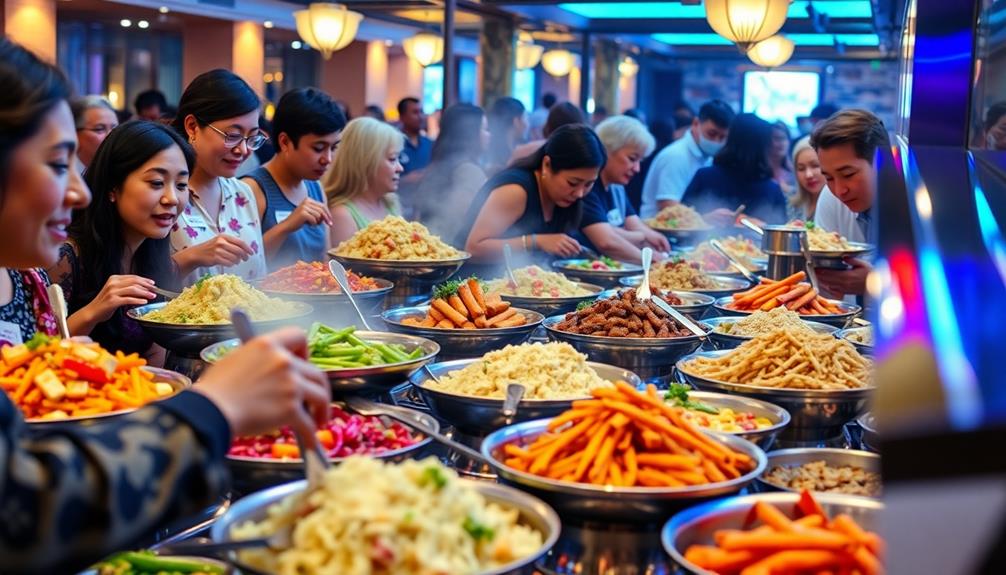
Buffets create a unique environment that considerably influences your food choices, often in unexpected ways. The abundance mindset that buffets foster can lead you to overconsume, driven by the urge to maximize the value of your fixed entry fee. You might find yourself piling your plate high, succumbing to the fear of missing out (FOMO) on the variety of options available, such as the temptation of delicious Turkey Sandwich leftovers. This desire to try everything often results in excessive portions.
As you navigate through a buffet, decision fatigue can set in. The overwhelming number of choices can create anxiety, pushing you to make impulsive decisions about what to eat. You may grab items without truly considering whether you really want them.
Moreover, psychological triggers play a significant role in your choices. The constant visibility of food, combined with its appealing presentation, can override your rational decision-making. You may end up eating more than intended, influenced by what you see rather than what your body needs. Furthermore, the psychology behind comfort food is a powerful force in shaping our eating habits. When we are feeling stressed or overwhelmed, the appeal of familiar, comforting foods can lead us to indulge in unhealthy options, further impacting our choices. This emotional connection to food can make it difficult to resist, even when we know that it may not be the best choice for our overall well-being.
Social dynamics also impact your choices, as you might unconsciously mirror the eating behaviors of those around you, leading to larger portion sizes.
Observational Behaviors at Buffets

When you enter a buffet, your behavior can reveal a lot about your eating habits. Observational studies show that if you have a higher Body Mass Index (BMI), you mightn't take the time to browse the buffet before serving yourself. This often results in larger portion sizes, as you're more likely to dive right in. The psychology behind this suggests that impulse plays a significant role in your choices.
Additionally, the presence of appealing dishes, such as a flavorful Caldeirada or vibrant salads, can entice you to serve yourself more than you typically would. Curiously, the utensils you choose can also impact your consumption. Using chopsticks typically leads to lower consumption rates compared to forks, illustrating how simple changes can influence how much you eat.
Behavioral patterns indicate that less than 10% of food at buffets goes uneaten, highlighting a strong tendency to maximize your consumption.
Group dynamics further complicate your eating habits. When you're surrounded by others, social cues can lead you to increase your portion sizes and adjust your food choices based on what they're selecting.
Emotional Responses to Dining
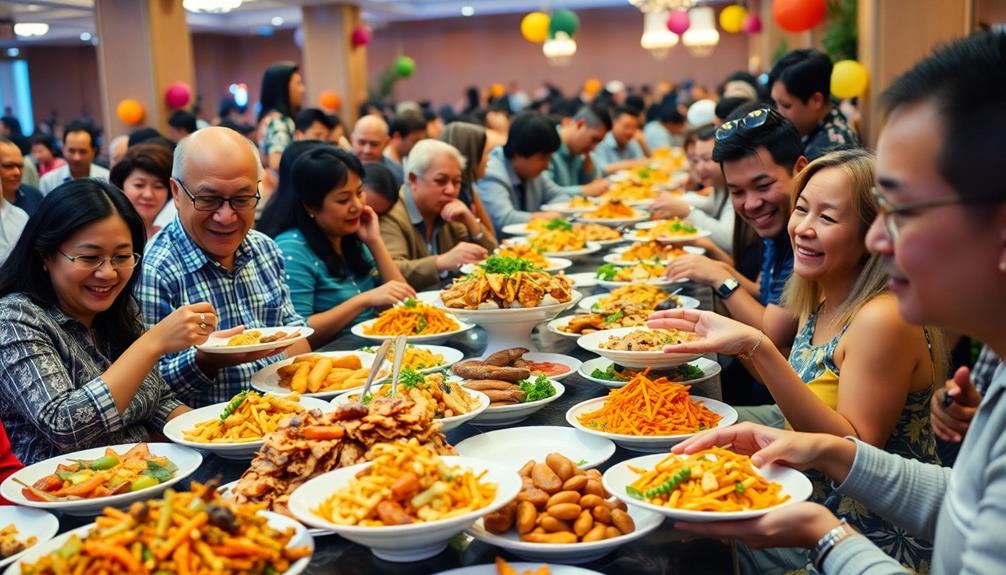
When you step into an all-you-can-eat buffet, you might feel a rush of joy at the endless variety of food options available, much like the excitement of discovering a fresh ingredient dish that highlights seasonal produce.
Yet, that excitement can quickly turn to anxiety as you grapple with making choices, and it's easy to overindulge, leaving you with a nagging sense of guilt afterward.
Balancing the thrill of variety with the weight of guilt and decision fatigue creates a complex emotional landscape that many diners navigate.
Overindulgence and Guilt
Overindulgence at all-you-can-eat buffets can lead to a whirlwind of emotional responses, particularly guilt and regret. When you fill your plate to the brim at the buffet line, it's easy to lose track of your intended portion sizes. This often results in feelings of discomfort after the meal.
You might experience:
- Guilt: After overindulging, you may feel remorse for not exercising self-control, wondering why you couldn't resist those extra helpings. This guilt can be compounded by the awareness of healthier, more balanced options available, such as Candy Corn Fruit Parfaits that offer a guilt-free sweet treat.
- Regret: You might look back and wish you'd made healthier choices or simply eaten less, leading to dissatisfaction with your dining experience.
- Anxiety: The constant visibility of food options can heighten stress, making it hard to resist the urge to overconsume.
Additionally, disappointment can creep in if your desired dishes aren't available or don't meet your expectations.
The frustration of maneuvering through crowded buffet lines can also amplify your emotional responses, leaving you feeling overwhelmed.
Ultimately, this combination of factors complicates your dining experience, making it a challenge to enjoy the variety without succumbing to guilt.
Joy of Variety
The joy of variety at an all-you-can-eat buffet can transform your dining experience into an exciting culinary adventure. When you walk in, the sight of diverse food options ignites your excitement and anticipation. Each dish presents an opportunity to indulge in something new or revisit a favorite, creating a sensory feast that tantalizes your taste buds and lifts your mood.
This abundance not only satisfies your cravings but also plays a significant role in your emotional response to dining. Many buffets may include comforting Southern dishes like satisfying fried pork chops, which add a familiar warmth to the experience.
You might feel sheer joy as you explore different cuisines, relishing the freedom to sample whatever you desire. The quality of the food can enhance this experience, making every bite a delight.
Dining at a buffet allows you to fill your belly as cheaply as possible, letting you savor a wide range of flavors without breaking the bank. Cultural backgrounds also influence your joy of variety, shaping what you find exciting or comforting.
Ultimately, the thrill of choice creates a unique atmosphere that can elevate your meal, making buffets a favorite for those seeking indulgence and culinary exploration.
Anxiety From Choices
While the joy of variety can be exhilarating, it often brings a different emotional response: anxiety from choices. Standing before an endless array of dishes, including options like Red-Braised Pork Belly and Sichuan Cold Noodles, you might feel overwhelmed, leading to decision fatigue.
This emotional turmoil can manifest in several ways:
- Overindulgence: You may feel pressured to sample everything, afraid of missing out on a delicious dish. This can lead to a plate piled high, and afterward, you might wrestle with feelings of guilt.
- Social Pressure: Watching others choose can heighten your anxiety. You might feel compelled to mimic their selections, even if they don't align with your preferences, complicating your dining experience.
- Environmental Distractions: The noise and hustle of a busy buffet can intensify your frustration. Waiting in line or maneuvering through crowds only adds to the stress, making it harder to focus on what you genuinely want to eat.
In the end, while buffets offer an enticing variety, the anxiety from choices can overshadow the experience, leaving you feeling frazzled rather than satisfied.
Understanding this dynamic can help you manage the buffet with more confidence and enjoyment.
Social Dynamics in Buffet Settings
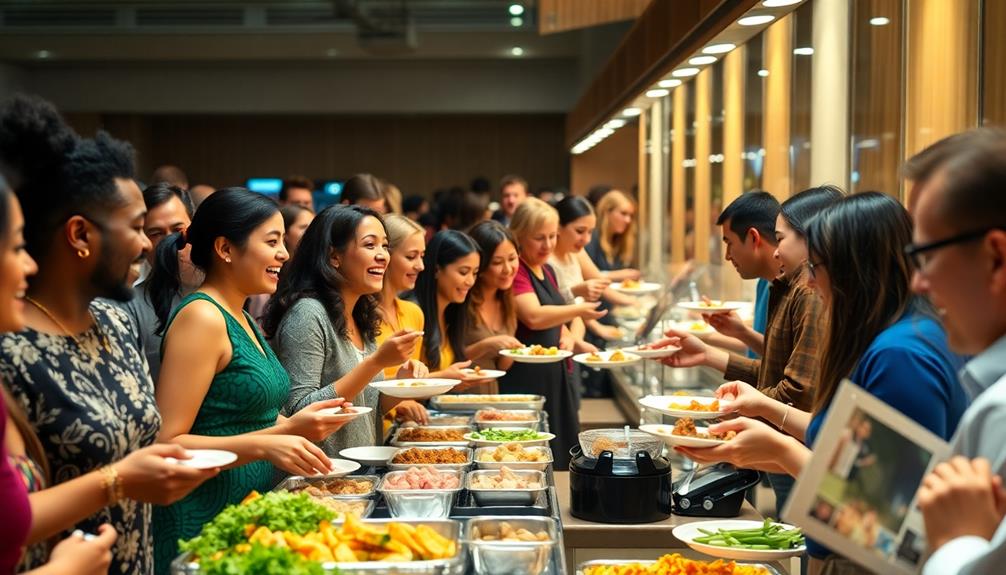
In buffet settings, social dynamics play an essential role in shaping your dining experience. You might notice that group behaviors often lead to competitive eating patterns, especially when diners aggressively go for the last servings. This competitive atmosphere can trigger a rush, impacting how much you enjoy your meal.
Those with higher patience levels tend to savor their food more, allowing for a more satisfying experience. The variety of dishes available, such as Chilaquiles, can also influence choices as diners may feel compelled to try a bit of everything.
The presence of peers can greatly influence your dietary decisions. You may feel pressured to conform to the eating habits of your companions, which can lead to increased portion sizes. This shared experience can enhance enjoyment, but it can also spark conflicts, particularly when preferences clash or one group monopolizes certain dishes.
Cultural etiquette further shapes buffet interactions. Depending on your background, you might approach food selection and sharing differently than others.
Understanding these social dynamics can help you navigate the buffet more effectively, allowing you to balance enjoyment and portion sizes while minimizing potential conflicts. Being aware of these factors can enhance your overall experience and make for a more enjoyable meal with others.
Profitability Challenges for Buffets

When you think about all-you-can-eat buffets, consider how tight their profit margins really are—often just a few dollars on a hefty bill.
The intense competition forces these establishments to get creative with their strategies, from managing food waste to adjusting menu prices.
For instance, many buffets might include popular dishes like Mushroom Masala to appeal to vegetarian customers while keeping costs manageable.
Understanding these challenges helps you appreciate the balance buffets strike between customer satisfaction and financial sustainability.
Profit Margins Overview
All-you-can-eat buffets face significant profitability challenges, often operating on razor-thin margins. With an average profit margin of just 3%, or $1.07 on a $40 bill, it's clear that maintaining profitability isn't easy.
Many establishments, especially in Las Vegas, rely on gambling revenue to offset their food operation losses, further complicating their financial landscape. Buffets often include popular comfort foods like loaded baked potatoes to attract customers, as these items are both satisfying and cost-effective.
To thrive, successful all-you-can-eat buffets need to balance customer satisfaction with cost control. Here are three key strategies they use to improve profit margins:
- Minimizing Food Waste: By carefully managing portion sizes and popular dishes, buffets can reduce waste and maximize the value of ingredients.
- Dynamic Pricing: Implementing higher prices during peak times can enhance the patron experience while improving profitability.
- Loyalty Programs: Offering discounts or incentives for repeat visits fosters customer loyalty, ensuring a steady flow of patrons.
In this challenging environment, buffets that prioritize these strategies can navigate the complexities of customer satisfaction while safeguarding their profit margins.
The robust market for all-you-can-eat buffets, especially in cities like Houston, demonstrates that with the right approach, success is attainable.
Competition and Strategies
Maneuvering through the competitive landscape of all-you-can-eat buffets can be intimidating, especially with so many options vying for your attention.
The buffet model often operates on thin profit margins, averaging just $1.07 profit on a $40 bill. This means buffets must employ strategic approaches to overcome profitability challenges.
In cities like Houston, where the demand for buffet dining remains strong, successful establishments balance customer satisfaction with cost control. They creatively manage menu offerings and food waste strategies to maximize profits while keeping diners happy.
Competition forces buffets to think outside the box. Many employ strategic pricing, placing high-cost items in less prominent areas to minimize consumption.
By ensuring food placement caters to diverse customer demographics, they enhance the overall dining experience without sacrificing profitability.
Despite the financial struggles faced by some, particularly in places like Las Vegas where many buffets rely on gambling revenue, the right strategies can lead to success.
For you, understanding these dynamics can enhance your dining experience, as you'll see how buffets work hard to create a satisfying yet profitable environment.
Menu Design Strategies
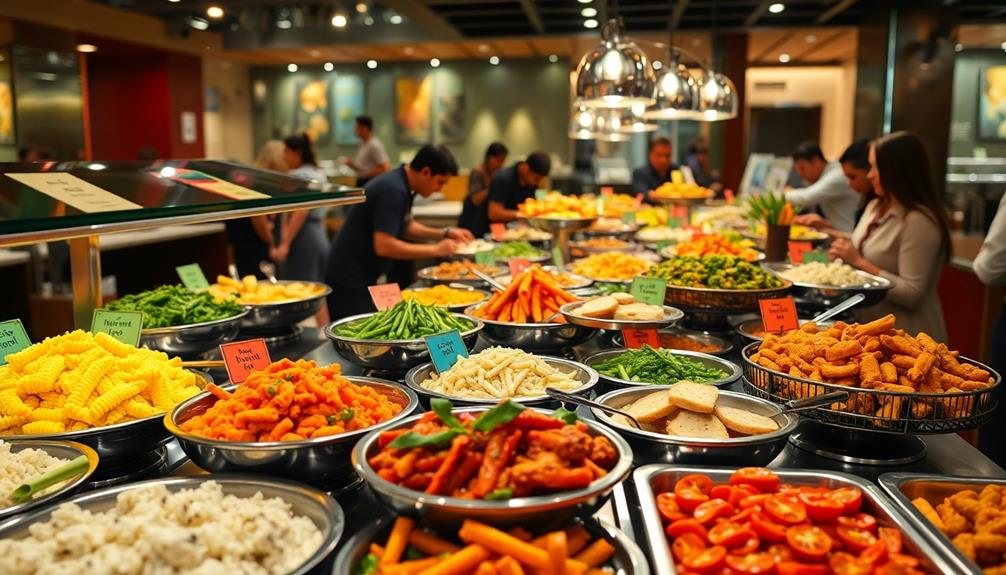
Strategically designed menus play a pivotal role in the success of AYCE buffets, balancing variety and cost-effectiveness. By leveraging smart menu design strategies, buffets can optimize their food items while adhering to the economics of all-you-can-eat.
Here are three key strategies they often use:
- Flexible Menu Adjustments: Buffets adjust their menus daily based on ingredient availability and cost, ensuring profitability and freshness.
- Strategic Food Placement: Filling items like rice and pasta are placed at the beginning of the buffet line, encouraging diners to load up on these cheaper options. More expensive proteins are positioned further down, limiting overconsumption.
- Portion Control Measures: Smaller plates and bowls help control how much food you take, effectively reducing overall consumption and minimizing waste.
Customer Behavior Patterns
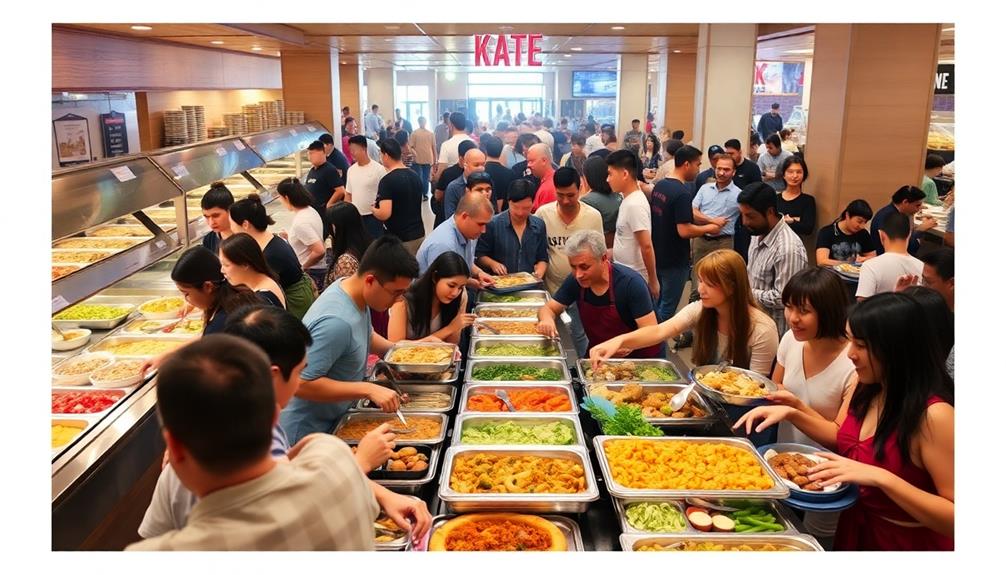
Many diners exhibit fascinating behavior patterns when traversing buffets, which can greatly influence their eating habits. For instance, those with a higher Body Mass Index (BMI) often dive straight in without browsing, leading to larger initial portion sizes. Behavioral cues in buffet design, like using smaller plates, can notably reduce the amount of food taken.
The table below highlights key customer behavior patterns in buffets:
| Behavior Pattern | Impact on Eating Habits |
|---|---|
| Browsing before serving | Smaller portion sizes |
| Using hands over utensils | Larger portion sizes |
| Group dining influence | Increased portion sizes |
| Buffet design (smaller plates) | Reduced overall consumption |
| Food wastage (less than 10% left) | Optimization of consumption |
Understanding these patterns can enhance your buffet experience. You'll notice how your choices are affected by those around you and how the layout influences your plate. By recognizing these behaviors, you can make more mindful decisions about your portion sizes and overall consumption while enjoying the variety a buffet has to offer.
Marketing Insights for Buffets
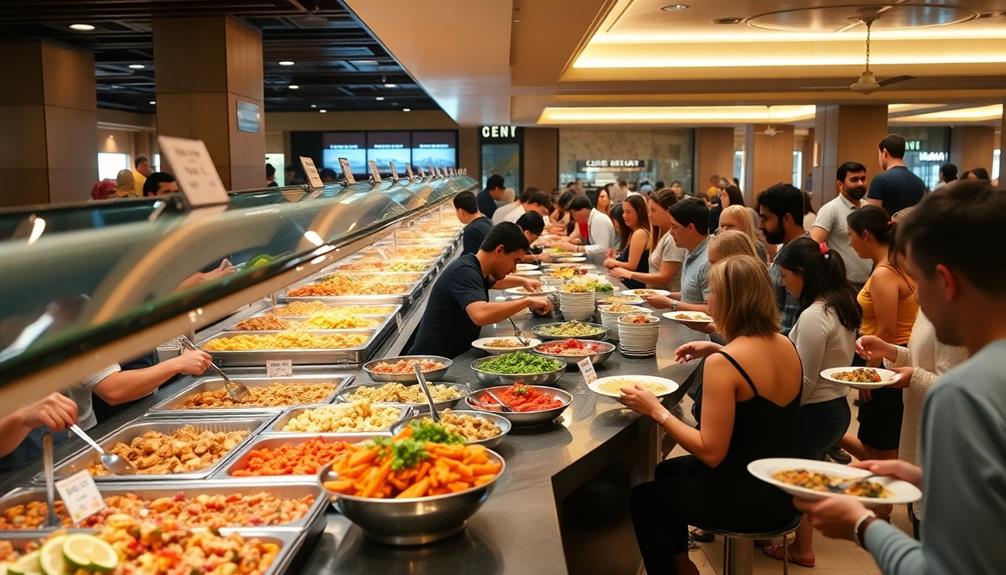
Buffets rely on clever marketing insights to maximize customer satisfaction and profitability. By strategically managing food and service, buffet managers can create an enticing experience while keeping costs in check.
Here are three key marketing strategies they employ:
- Smaller Plates and Bowls: Using smaller dishware limits the amount of food diners take, reducing waste and encouraging them to return for more rather than overloading their plates.
- Strategic Food Placement: Positioning filling items like rice and pasta at the start of the buffet line entices customers to fill up on lower-cost foods, maximizing profits.
- Pricing Tactics: Charging separately for soft drinks boosts profit margins greatly. This method helps balance out the average consumer's tendency to consume food costing less than the buffet price.
Frequently Asked Questions
What Are the Benefits of the All-You-Can-Eat Buffet?
At an all-you-can-eat buffet, you enjoy diverse cuisines, savoring new dishes without breaking the bank. The fixed price encourages you to indulge, making it perfect for family gatherings and social dining experiences with friends.
Why Do People Tend to Eat More at All-You-Can-Eat Buffet Restaurants?
Eating at an all-you-can-eat buffet feels like being a kid in a candy store. You see endless options, and the fixed price tempts you to load up, often ignoring your body's signals of fullness.
What Is the Meaning of All-You-Can-Eat Buffet?
An all-you-can-eat buffet means you can enjoy unlimited food for a fixed price. It offers a variety of dishes, encouraging you to explore different flavors and eat as much as you want.
Can an All-You-Can-Eat Buffet Cut You Off?
Yes, an all-you-can-eat buffet can cut you off. If you overindulge excessively or attempt to take food home, they might enforce their policies to maintain a balance between customer enjoyment and operational efficiency.
Conclusion
In exploring the psychology of all-you-can-eat buffets, you can see how your choices, emotions, and social interactions shape your experience. Picture yourself at a bustling buffet, your plate piled high with colorful dishes, driven by the thrill of value. As you savor each bite, you might notice how the atmosphere and your companions influence what you choose. Understanding these dynamics can enhance not just your dining experience but also the strategies that buffets use to keep you coming back for more.
Caterina, with her background as a food scientist and innovative chef, is the driving force behind our product development. Her keen eye for detail and relentless pursuit of perfection guide her as she curates our collection of extraordinary ingredients, beverages, and culinary experiences. Whether she’s sourcing the rarest spices or collaborating with master artisans, Caterina’s passion for elevating the culinary landscape shines through in every new discovery that graces our shelves.
-

 Italian Cuisine5 months ago
Italian Cuisine5 months agoWhat Italian Dishes Use Parsley
-

 Vetted5 months ago
Vetted5 months ago12 Best Coffee Pods for DeLonghi Espresso Machine to Elevate Your Caffeine Game
-

 Vetted2 months ago
Vetted2 months ago15 Best Non-Toxic Espresso Machines for a Healthier Brew at Home
-

 Vetted3 months ago
Vetted3 months ago15 Best Coffee Beans for Your Breville Espresso Machine – Expert Picks for Perfect Brews
-

 Vetted5 months ago
Vetted5 months ago15 Best Commercial Automatic Espresso Machines for Your Coffee Shop
-

 Vetted2 months ago
Vetted2 months ago15 Best Coffee Beans to Elevate Your Breville Espresso Experience
-

 Vetted5 months ago
Vetted5 months ago15 Best ESE Pod Espresso Machines for Perfect Coffee Every Time
-

 Halloween-Themed Recipes4 weeks ago
Halloween-Themed Recipes4 weeks agoSpiderweb Black Bean Dip




























